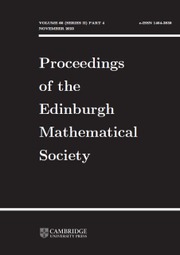No CrossRef data available.
Article contents
Twisted Rokhlin property for mapping class groups
Published online by Cambridge University Press: 02 September 2025
Abstract
Given an automorphism ϕ of a group G, the map  $(g,h) \mapsto gh\phi(g)^{-1}$, defines a left action of G on itself, whose orbits are called the ϕ-twisted conjugacy classes. In this paper, we consider two interesting aspects of this action for mapping class groups, namely, the existence of a dense orbit and the count of orbits. Generalising the idea of the Rokhlin property, a topological group is said to exhibit the twisted Rokhlin property if, for each automorphism ϕ of the group, there exists a ϕ-twisted conjugacy class that is dense in the group. We provide a complete classification of connected orientable infinite-type surfaces without boundaries whose mapping class groups possess the twisted Rokhlin property. Additionally, we prove that the mapping class groups of the remaining surfaces do not admit any dense ϕ-twisted conjugacy class for any automorphism ϕ. This supplements the recent work of Lanier and Vlamis on the Rokhlin property of big mapping class groups. Regarding the count of twisted conjugacy classes, we prove that the number of ϕ-twisted conjugacy classes is infinite for each automorphism ϕ of the mapping class group of a connected orientable infinite-type surface without boundary.
$(g,h) \mapsto gh\phi(g)^{-1}$, defines a left action of G on itself, whose orbits are called the ϕ-twisted conjugacy classes. In this paper, we consider two interesting aspects of this action for mapping class groups, namely, the existence of a dense orbit and the count of orbits. Generalising the idea of the Rokhlin property, a topological group is said to exhibit the twisted Rokhlin property if, for each automorphism ϕ of the group, there exists a ϕ-twisted conjugacy class that is dense in the group. We provide a complete classification of connected orientable infinite-type surfaces without boundaries whose mapping class groups possess the twisted Rokhlin property. Additionally, we prove that the mapping class groups of the remaining surfaces do not admit any dense ϕ-twisted conjugacy class for any automorphism ϕ. This supplements the recent work of Lanier and Vlamis on the Rokhlin property of big mapping class groups. Regarding the count of twisted conjugacy classes, we prove that the number of ϕ-twisted conjugacy classes is infinite for each automorphism ϕ of the mapping class group of a connected orientable infinite-type surface without boundary.
Keywords
MSC classification
Information
- Type
- Research Article
- Information
- Copyright
- © The Author(s), 2025. Published by Cambridge University Press on behalf of The Edinburgh Mathematical Society.


